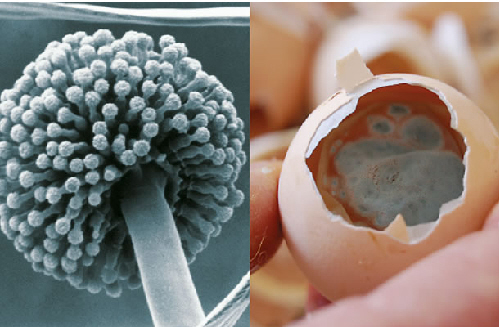



Keeping the Hatchery Free of Aspergillus
Advice on the prevention and treatment of Aspergillus mould in the hatchery from Marleen Boerjan of Pas Reform.Aspergillosis is a fungal infection of the respiratory tract in young birds, also commonly known as ‘brooder pneumonia’. In infected birds, the air sacs and lungs show white to yellow spots or lesions. Infected birds gasp for air and have accelerated breathing. Aspergillosis can also result in severe eye (and even brain) infection, which can appear as a yellow cheesy pellet beneath the eyelid. Increased mortality rates of 5 to 50 per cent may occur within 21 days after the placement of diseased birds.
Day-old chicks with signs of Aspergillosis are infected by the spores of Aspergillus species, among which Aspergillus fumigatus is the most common. The spores of the fungus Aspergillus are like small, dry seeds that can easily be spread by draught or the wind. The spores are found in low numbers throughout the whole environment. Aspergillus spores survive and grow in a wide range of conditions, but especially on organic matter, like egg yolk, cardboard boxes and wood. Growth in the spores is initiated by conditions of high humidity and temperature (37 to 45°C). Cycles of high and low humidity optimise the growth of the fungus (mycelium) and the spread of its spores. The hatchery therefore provides optimum environmental conditions for Aspergillus to thrive.
Aspergillus spores can enter the hatchery either directly via the eggs, or via incoming air.
When the hatchery environment is contaminated by a high level of Aspergillus, the spores can easily enter the air handling unit and ventilation system. The climate, temperature and humidity in ventilation ducts is ideal for the propagation of Aspergillus, especially when organic matter (debris) has accumulated.
The main route into the hatchery for Aspergillus spores however, is usually via contaminated eggs. Aspergillus spores attached to the shell find their way into the albumen and yolk via hairlines or cracks in the shell. The yolk of the egg is an ideal substrate for the growth of Aspergillus and once the spores have entered the eggs, the way to the hatchery is open.
The nests also contain several sources of Aspergillus, including bedding, manure and feed. The nest eggs therefore become contaminated by contact with Aspergillus spores from these sources. Floor eggs also, of course, have a high risk of being heavily contaminated, when the spores enter the egg via hairline and other cracks.
Initially, infection by Aspergillus will be found during the routine analysis of unhatched eggs. Infected eggs show a visible mould on the membrane in the air cell (see picture below). The risk of a serious bloom of Aspergillus is high when 0.5 per cent of the hatching eggs show clear infection with a visible growth of the fungus. Also, the frequency of embryos dying at about day 16 is higher then expected.

Advice A
Prevention is of course the first line of action. To prevent Aspergillus infection in the hatchery, the following measures are recommended:
- Use Hatchery Recording Forms to ensure that the origin of eggs is traceable.
- Do not incubate floor eggs.
- Do not incubate cracked eggs or eggs with hairlines.
- Avoid wooden walls, ceilings or surfaces in the hatchery, since Aspergillus thrives well on wooden surfaces,.
- Analyse unhatched eggs on a regular basis - and if infected eggs are found, take measures to trace the sources of Aspergillus (see B).
- Ensure your hatchery sanitation programme is fully maintained. If moulds are found, take immediate measures to clean the hatchery (see B).
- Ensure that your hatchery sanitation programme includes the cleaning and disinfection of ventilation ducts.
- Remember that hatchery equipment must be free of all organic matter before disinfection. It makes no sense to disinfect equipment, trays or boxes when debris remains stuck to the surfaces.
Advice B
If Aspergillus has been found in the hatchery the following is recommended:
- Thoroughly clean and disinfect the hatchery - including ventilation ducts - with an effective fungicide. If necessary, ask your supplier for advice on the most effective solution.
- Apply the fungicide at a regular interval because the spores of Aspergillus species are highly resistant to fungicides. Any surviving spores will develop into a mature spore-producing mould , thus the fungicide should be applied before this stage of development is reached.
- Trace and eliminate the source of the Aspergillus spores, the main source of which is usually found at the breeder farm in the (wooden) nest-boxes, litter, cardboard boxes and wooden walls or ceilings.
June 2014











